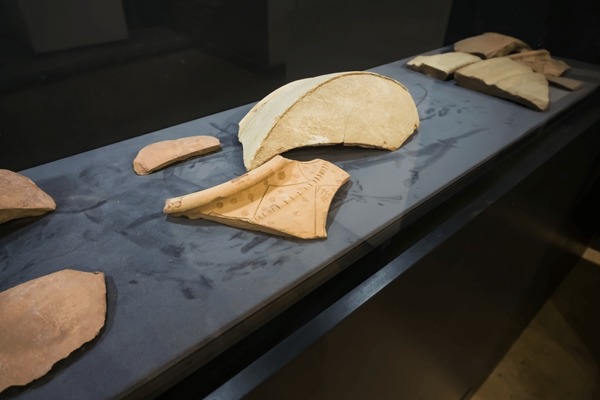Archaeology, as a discipline, provides invaluable insights into past human behaviors, cultural practices, and societal structures through the study of material artifacts. Among these artifacts, pottery emerges as a significant medium that encapsulates the essence of an era’s technological capabilities, aesthetic expressions, and functional requirements. A recent discovery of an archaeological pot featuring holes prompts a fascinating examination of its design, utility, and cultural implications, particularly through the lens of cultural relativism.
The pot’s distinct morphology—characterized by its perforated surface—raises immediate questions regarding its intended function. In various cultures, vessels have served multiple purposes; however, the existence of holes suggests a possible deviation from traditional usage. This irregularity tantalizes archaeologists, for it may indicate specialized utilitarian roles or signify ritualistic aspects which surpass mere practicality. One hypothesis postulates that it could have been employed as a sieve, enabling the drainage of liquids while retaining solids. Alternatively, the pot might possess ceremonial significance, with holes serving as symbolic openings through which offerings are made or connected to a conception of the divine.
Upon examining the aesthetics of the perforated pot, one must consider how its design intersects with broader cultural narratives and artistic expressions. Artisans and potters often imbue their creations with visual motifs that communicate cultural ideologies and beliefs. The strategical placement of holes, perhaps accompanied by ornamental carvings, could reflect a unique worldview or spiritual narrative pertinent to the society that produced it. Each hole may signify a connection to natural elements, such as water or earth, evoking concepts of fertility, life, or death.
If we delve deeper into the implications of such an object from a cultural relativism perspective, it becomes evident that understanding the pot necessitates suspending ethnocentric perceptions. The interpretation of the holes is not universally applicable; rather, it is contingent upon the socio-cultural context from which the pot emerged. In cultures where water scarcity is prevalent, for instance, the pot might reflect innovative adaptations to environmental challenges. Conversely, in societies heavily engaged in ritualistic practices, the presence of holes might underscore intrinsic beliefs regarding connectivity to the cosmos or ancestral spirits.
The pot, therefore, serves as a microcosm of its society, offering glimpses into the complexities of human experience. While it may superficially appear as a simple object, its design language invites multifaceted interpretations prompting a reassessment of cultural artifacts as reflections of diverse human experiences. Cultural relativism compels us to acknowledge that no single narrative can wholly encapsulate its meanings. Instead, an inclusive understanding accommodates varying interpretations rooted in distinct cultural frameworks.
Furthermore, the discovery of the pot with holes propels a reconsideration of archaeological methodologies. Traditional excavation techniques often prioritize context and stratigraphy; however, such an artifact invites interdisciplinary approaches. The integration of anthropology, art history, and even sociolinguistics in analyzing its implications enriches our comprehension. This confluence of disciplines is crucial for developing a holistic understanding, as it transcends a purely materialistic view and gives weight to symbolic interpretations.
This intersectionality also extends to contemporary artisans, whose creations may draw inspiration from ancestral techniques while innovating new forms. By studying such archaeological finds, modern potters can engage in a dialogue with their heritage, perhaps evoking the same cultural reverence that defined the original creator’s intent. In this manner, the pot serves both as a historical artifact and a contemporary muse, underscoring the continual influence of the past on present artistic expressions.
As the archaeological community further investigates the implications of such findings, the pot’s unique shape also provides insights into technological advancements among ancient peoples. The crafting of pottery with holes may illustrate a mastery of design and function, revealing sophisticated knowledge of material properties. The ability to manipulate clay to produce both aesthetic and functional qualities showcases an understanding of physical properties that fosters an appreciation for the innovative strengths of ancient societies.
The societal implications extend beyond mere utilitarianism, as the collective knowledge encapsulated within the pot encompasses social structures, hierarchies, and community practices. It is plausible that the creation and use of such a pot were communal activities, involving collaborative efforts that strengthen social bonds and embody the cultural zeitgeist of the time. Rituals associated with the pot’s use may have fostered identity formation, anchoring individuals in a shared sense of belonging and purpose.
The perforated pot thus constitutes a poignant symbol of the interplay between form and function, tradition and innovation, individual and community. Its existence challenges prevailing notions of superiority in contemporary craftsmanship, asserting that the richness of cultural heritage deserves recognition and respect. As archaeological interpretations evolve, they must elevate the discourse surrounding artifacts, promoting a narrative where each object—like the pot with holes—is not merely a relic of the past but a precious reminder of the intricate tapestry that defines human civilization.
In conclusion, the archaeological pot with holes serves as more than an artifact of bygone eras; it prompts profound inquiries into the essence of cultural identity and expression. Embracing a cultural relativism perspective encourages a nuanced understanding of the artifact’s role within its original societal context while stimulating curiosity about the complex narratives woven into every facet of human existence. Each hole carved into the clay rattles the foundations of traditional narratives, promising a richer discourse surrounding the human experience as intertwined and culturally diverse.
